Site WW11
Location: Lillimur
Australian Soil Classification: Hypercalcic, Mottled-Hypernatric, Brown SODOSOL
Northcote Factual Key: Db4.43
Great Soil Group: solodised solonetz
General Landscape Description: This site is on the crest of a low rise. It occurs in association with WW12. Older weathered Parilla Sandstone can occur at depth. More recent aeolian sediments (Woorinen Formation) have also occurred
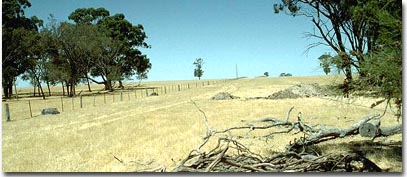 Site WW11 Landscape |
Soil Profile Morphology:
Surface Soil
| A1 | 0-20 cm | Dark brown (10YR3/3) loamy sand; structureless; weak consistence when dry; pH 6.1: | 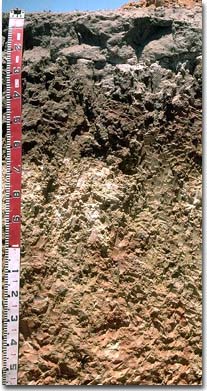 Site WW11 Profile |
| A2 | 20-25 cm | Pale brown (10YR6/3) loamy sand; conspicuously bleached; structureless; weak consistence when dry; discontinuous across soil pit; pH 6.9; sharp transition to: | |
| Subsoil | |||
| B21 | 25-65 cm | Brown (10YR4/3) medium heavy clay; many coarse distinct yellowish brown and red mottles; strong columnar structure (peds >200 mm), parting to moderate blocky structure (peds 50-100 mm); very strong consistence when dry; complete dispersion; colour changes to strong brown (7.5YR5/6) at depth and mottle abundance decreases; pH 7.5: | |
| B22k | 65-100 cm | Pink (7.5YR7/4) medium clay (fine sandy); fine distinct reddish yellow mottles are common; moderate prismatic structure (peds 50-100 mm), parting to blocky structure (peds 20-50 mm); many (40%) soft calcium carbonate segregations and a few (5%) hard silica/carbonate nodules; strong dispersion; horizon is discontinuous; carbonate forming large patches in places; pH 9.6: | |
| B23 | 100-130 cm | Reddish yellow (7.5YR7/6) medium clay (coarse sandy); yellowish red mottles are common; pH 9.7: | |
| BC | 130-180+ cm | Partially weathered sandstone. | |
Horizon | pH | Salinity | Internal Drainage | Hydro-phobicity | ||
Surface (A1 horizon) | slightly acid | low | - | - | - | moderate |
Subsoil (B21 horizon) | slightly alkaline | low | strongly sodic | complete | imperfectly drained1 | - |
Deeper subsoil (at 1 metre) | extremely alkaline | medium | - | strong | - | - |
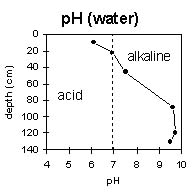 | 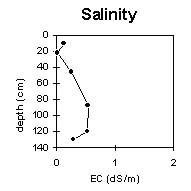 | 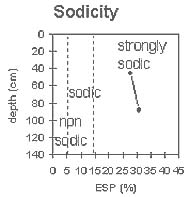 | 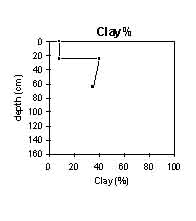 |
Key Profile Features:
- Sandy surface soil.
- Hydrophobic surface soil.
- Strong texture contrast between surface soil and subsoil.
- Bleached A2 horizon.
- Coarse columnar structure in upper subsoil.
- Sodic clay subsoil.
- Dispersive subsoil.
- Mottled subsoil.
- Weathered sandstone comes in at around 130 cm.
Feature | Result | Management Prescription |
| Sandy surface soil. |
| Dryland cropping.
|
| Hydrophobic surface soil. |
|
|
| Bleached A2 horizon. |
| Dryland cropping.
|
| Strong textural contrast between surface soil and subsoil (duplex). |
|
|
| Sodic clay subsoil. |
|
|
| Columnar or prismatic subsoil structure. |
|
|
| Dispersion (dry soil). |
| Dryland cropping.
|
| Mottled subsoil. |
|
|
Land Suitability Rating Table:
LAND USE | SUITABILITY CLASS | MAJOR LIMITING COMPONENT |
| Wheat | 2 | Climate, landscape, soil |
| Canola | 2 | Climate, landscape, soil |
| Chickpeas | 3 | Soil |
| Lentils | 3 | Soil |
| White clover seed | 2 | Soil |
| Lucerne for seed production | 3 | Soil |
| Viticulture | 3 | Soil |
| Apples | 2 | Climate, soil |
| Potatoes | 3 | Soil |
| Carrots | 3 | Soil |
| Onions | 3 | Soil |
| Sweet corn | 3 | Soil |
| Radiata Pine | 3 | Climate, soil |
| Blue Gum | 3 | Climate, soil |
Land Suitability Assessment and Primary Limitations:
| Wheat | Climate | 2 | Moderate frost risk, slightly high rainfall. |
| Landscape | 2 | Wind erosion hazard. | |
| Soil | 2 | Slightly impeded internal drainage, hydrophobicity. | |
| Canola | Climate | 2 | Moderate frost risk. |
| Landscape | 2 | Wind erosion hazard. | |
| Soil | 2 | Slightly impeded internal drainage, hydrophobicity. | |
| Chickpeas | Climate | 2* | Moderate frost risk, moderate to high rainfall. |
| Landscape | 2 | Wind erosion hazard. | |
| Soil | 3 | Sandy surface soil texture, impeded internal drainage. | |
| Lentils | Climate | 2 | Moderate frost risk, slightly high rainfall. |
| Landscape | 2 | Wind erosion hazard. | |
| Soil | 3 | Sandy surface soil texture, impeded internal drainage. | |
| White clover seed | Climate | 1 | No major limitation. |
| Landscape | 1 | No major limitation. | |
| Soil | 2 | Slightly alkaline subsoil pH, soil salinity, slightly impeded internal drainage, hydrophobicity. | |
| Lucerne for seed production | Climate | 1 | No major limitation. |
| Landscape | 2 | Wind erosion hazard. | |
| Soil | 3 | Impeded internal drainage. | |
| Viticulture | Climate | 2 | Moderate frost risk. |
| Landscape | 1 | No major limitation. | |
| Soil | 3 | Impeded internal drainage. | |
| Apples | Climate | 2 | Moderate frost risk, slightly high mean maximum January temperature. |
| Landscape | 1 | No major limitation. | |
| Soil | 2 | Soil salinity, slightly impeded internal drainage, hydrophobicity. | |
| Potatoes | Climate | 2 | Slightly high mean maximum January temperature. |
| Landscape | 2 | Wind erosion hazard. | |
| Soil | 3 | Impeded internal drainage. | |
| Carrots | Climate | 1 | No major limitation. |
| Landscape | 2 | Wind erosion hazard. | |
| Soil | 3 | Impeded internal drainage, shallow surface soil. | |
| Onions | Climate | 2 | Moderate frost risk. |
| Landscape | 2 | Wind erosion hazard. | |
| Soil | 3 | Impeded internal drainage. | |
| Sweet corn | Climate | 2 | Slightly low mean monthly temperature (October-March). |
| Landscape | 2 | Wind erosion hazard. | |
| Soil | 3 | Sandy surface soil. | |
| Radiata Pine | Climate | 3 | Low rainfall. |
| Landscape | 2 | Wind erosion hazard. | |
| Soil | 3 | Depth to sandstone. | |
| Blue Gum | Climate | 3 | Low rainfall. |
| Landscape | 2 | Wind erosion hazard. | |
| Soil | 3 | Depth to sandstone. |
Profile Described By: Mark Imhof, Nathalie Baxter (08/01/97).


